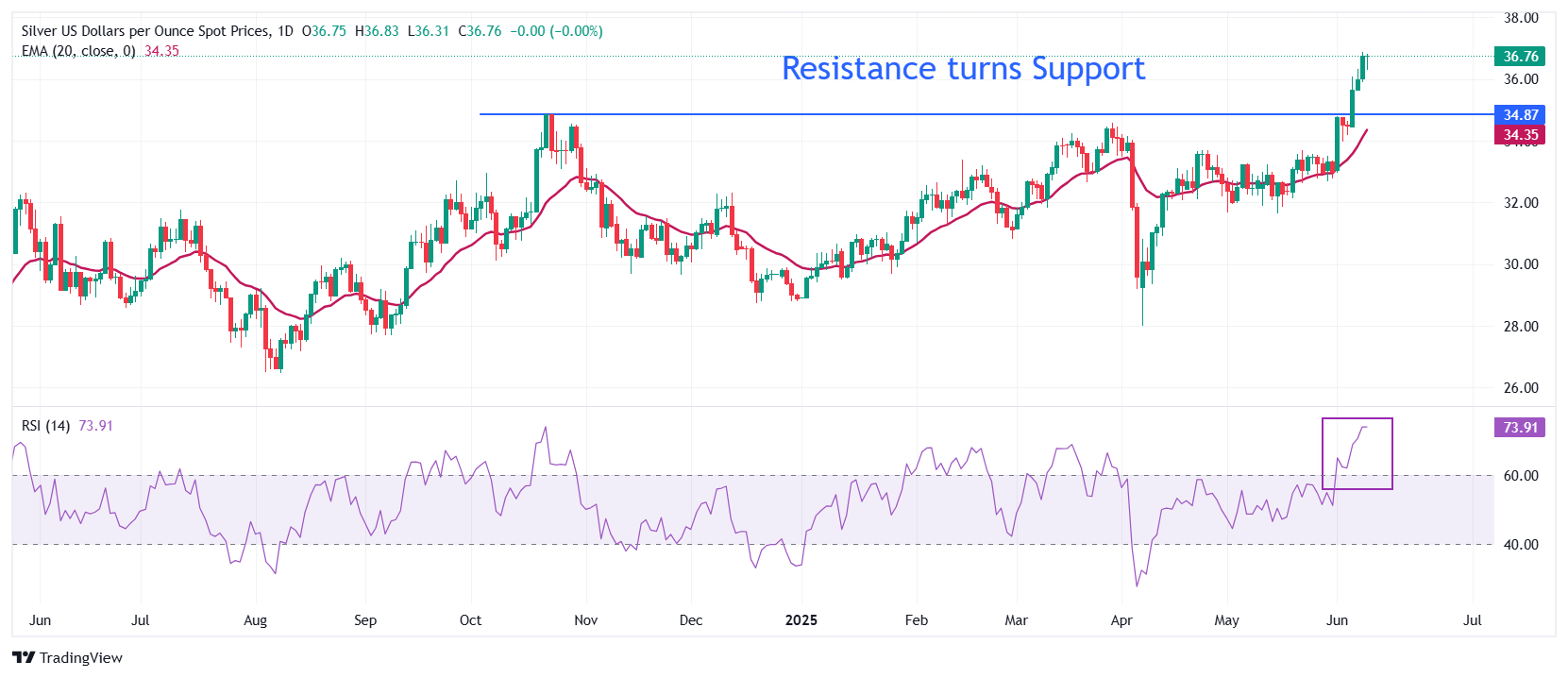Silver Price Forecast: XAG/USD rebounds to near $36.70, US-China trade talks in focus
- Silver price recovers early losses and recovers to near $36.70 while investors await the outcome of trade talks between the US and China.
- Washington has expressed confidence that Sino-US trade talks are going well.
- The US inflation is estimated to have grown at a faster pace in May.
Silver price (XAG/USD) claws back initial losses and rebounds to near $36.70 from the intraday low of $36.30 during European trading hours on Tuesday. The white metal recovers amid uncertainty over the outcome of trade talks between the United States (US) and China in London, which have entered the second day.
During European trading hours, the White House has signaled that trade discussions between the two nations are going well and negotiation will continue the entire day.
Theoretically, the optimism on Sino-US-trade discussions should diminish the demand of safe-haven assets, such as Silver.
Meanwhile, the US Dollar Index (DXY) trades calmly around 99.70, awaiting the US-China meeting minutes.
On the domestic front, investors await the US Consumer Price Index (CPI) data for May, which will be released on Wednesday. The inflation data is expected to show that price pressure grew at a faster pace.
Signs of accelerating inflationary pressures would allow the Federal Reserve (Fed) to maintain interest rates at their current levels for lone
The appeal of the Silver price increases in a high-inflation environment, higher hogher interest rates by the Federal Reserve (Fed) bode poorly for non-yielding assets, such as Silver.
Silver technical analysis
Silver price advances to near $36.20 after breaking above the key resistance plotted from the October 22 high of $34.87, which will act as a key support now. Advancing 20-day Exponential Moving Average (EMA) near $34.34 suggests that the near-term trend is bullish.
The 14-day Relative Strength Index (RSI) jumps above 70.00, indicating a strong bullish momentum.
Looking up, psychological level of $40.00 will be the major resistance for the Silver price. On the downside, the October 22 high of $34.87 will act as key support for the asset.
Silver daily chart

Silver FAQs
Silver is a precious metal highly traded among investors. It has been historically used as a store of value and a medium of exchange. Although less popular than Gold, traders may turn to Silver to diversify their investment portfolio, for its intrinsic value or as a potential hedge during high-inflation periods. Investors can buy physical Silver, in coins or in bars, or trade it through vehicles such as Exchange Traded Funds, which track its price on international markets.
Silver prices can move due to a wide range of factors. Geopolitical instability or fears of a deep recession can make Silver price escalate due to its safe-haven status, although to a lesser extent than Gold's. As a yieldless asset, Silver tends to rise with lower interest rates. Its moves also depend on how the US Dollar (USD) behaves as the asset is priced in dollars (XAG/USD). A strong Dollar tends to keep the price of Silver at bay, whereas a weaker Dollar is likely to propel prices up. Other factors such as investment demand, mining supply – Silver is much more abundant than Gold – and recycling rates can also affect prices.
Silver is widely used in industry, particularly in sectors such as electronics or solar energy, as it has one of the highest electric conductivity of all metals – more than Copper and Gold. A surge in demand can increase prices, while a decline tends to lower them. Dynamics in the US, Chinese and Indian economies can also contribute to price swings: for the US and particularly China, their big industrial sectors use Silver in various processes; in India, consumers’ demand for the precious metal for jewellery also plays a key role in setting prices.
Silver prices tend to follow Gold's moves. When Gold prices rise, Silver typically follows suit, as their status as safe-haven assets is similar. The Gold/Silver ratio, which shows the number of ounces of Silver needed to equal the value of one ounce of Gold, may help to determine the relative valuation between both metals. Some investors may consider a high ratio as an indicator that Silver is undervalued, or Gold is overvalued. On the contrary, a low ratio might suggest that Gold is undervalued relative to Silver.

